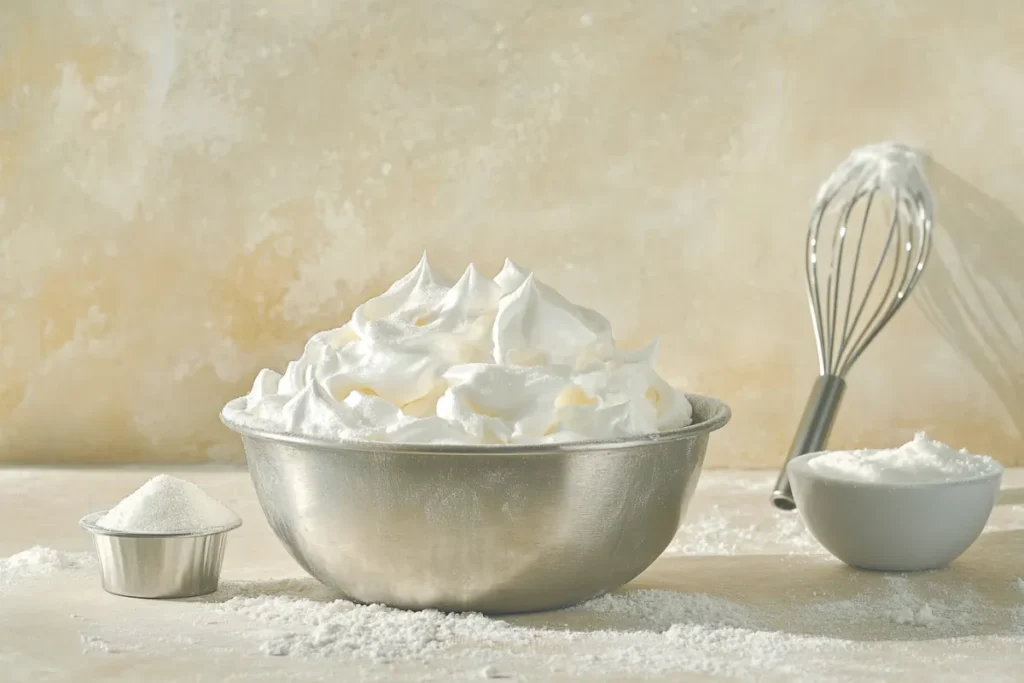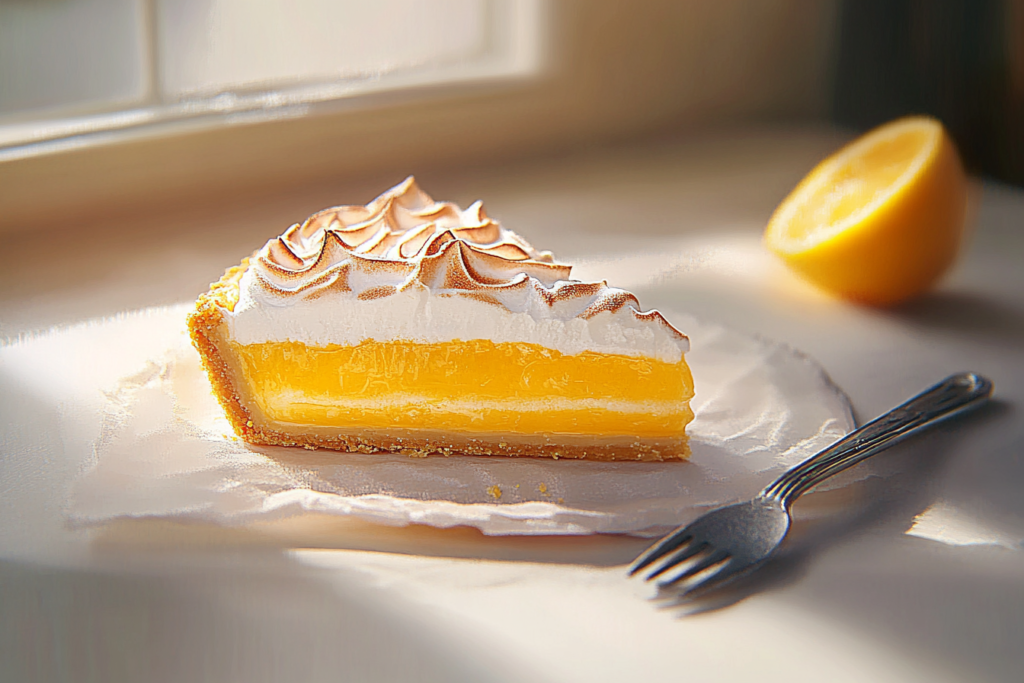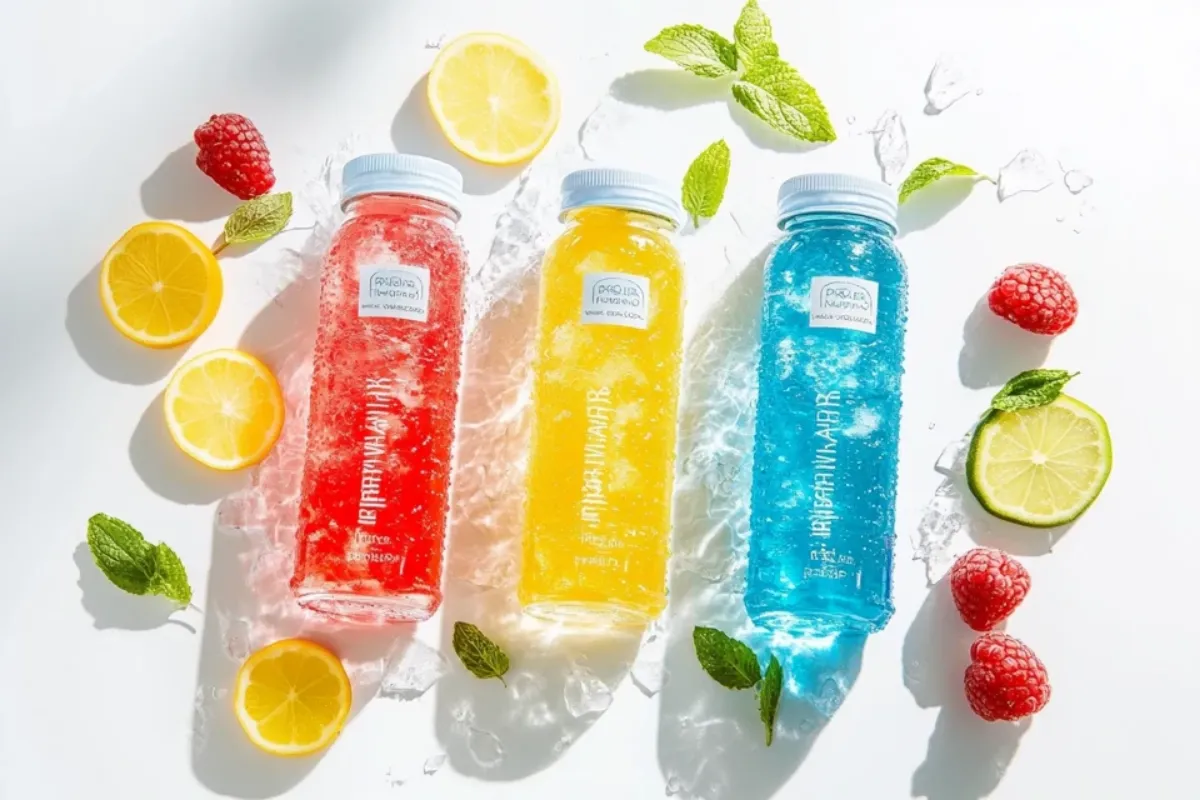Introduction
Meringue is one of the most versatile and fascinating components in the world of baking and desserts. Whether you’re indulging in a classic lemon meringue pie, savoring delicate meringue cookies, or marveling at a pavlova, this airy creation elevates any sweet treat. In this article, we’ll explore everything you need to know about meringue—from its rich meringue history and different types to foolproof tips for making it perfect. Let’s whip up some knowledge and dive into the world of meringue!
What is Meringue?
Definition of Meringue
Meringue is a sweet, airy mixture made primarily of egg whites and sugar. When whipped together, these ingredients create a light, fluffy foam that can be baked or used as a topping. The hallmark of a perfect meringue is its smooth, glossy finish and its ability to hold its shape, forming either stiff peaks or soft clouds, depending on its use.
But meringue isn’t just a fancy foam! It’s a foundation for some of the most cherished desserts in the culinary world. Its versatility makes it an essential skill for bakers and dessert enthusiasts alike.
Key Ingredients of Meringue
The simplicity of meringue lies in its ingredients, but their roles are crucial:
- Egg whites: The backbone of meringue, creating structure and volume.
- Sugar: Adds sweetness and stabilizes the foam, ensuring it holds its shape.
- Stabilizing agents like cream of tartar or vinegar are often added to help achieve the ideal consistency and prevent deflation.
Common Uses of Meringue
Meringue shines as both a centerpiece and a supporting act in countless recipes:
- As a topping: Think lemon meringue pie or baked Alaska, where it adds a light, marshmallow-like finish.
- In desserts: Pavlova, macarons, and meringue cookies are just a few creations that rely on meringue’s unique texture.
- As a garnish: Tiny, piped meringue shapes can decorate cakes or add texture to plated desserts.
Looking for a perfect companion to your meringue-based desserts? Explore our Fluffy Pancake Recipe for a breakfast delight!
The Origins of Meringue
The exact origin of meringue remains a bit of a mystery, with several countries laying claim to its creation. The term “meringue” first appeared in print in François Massialot’s 1692 cookbook. Some sources attribute its invention to a Swiss pastry cook named Gasparini in the 18th century. However, earlier recipes resembling meringue, referred to as “white biskit bread,” have been found in English manuscripts dating back to 1604. citeturn0search12
Meringue in Different Cultures
Over time, meringue has been embraced and adapted by various cultures. In France, it’s a staple in desserts like île flottante (floating island) and macarons. The United States boasts the classic lemon meringue pie and baked Alaska. In Australia and New Zealand, the pavlova—a meringue-based dessert topped with fruit and cream—is a beloved treat. Each culture has added its unique twist, showcasing meringue’s versatility and global appeal.
Famous Historical Dishes Featuring Meringue
Meringue has played a starring role in numerous iconic desserts throughout history. The French macaron, a delicate almond meringue cookie filled with ganache or buttercream, has been a favorite since the 19th century. The pavlova, named after Russian ballerina Anna Pavlova, features a crisp meringue shell with a soft center, adorned with whipped cream and fresh fruit. In the U.S., baked Alaska combines meringue, cake, and ice cream, creating a dramatic presentation when flambéed. These desserts highlight meringue’s adaptability and enduring popularity across different eras and regions.
Types of Meringue
French Meringue: The Classic
French meringue, often referred to as “basic meringue,” is the simplest and most common form. It’s made by beating egg whites until they form soft peaks, then gradually adding sugar until stiff peaks develop. This method produces a light, airy mixture that’s ideal for folding into batters or baking into crisp meringue cookies. However, French meringue is the least stable of the three types and should be used promptly after preparation. citeturn0search2
Swiss Meringue: Stable and Versatile
Swiss meringue is created by gently heating egg whites and sugar over a bain-marie (double boiler) until the sugar dissolves and the mixture reaches a temperature of about 71°C (160°F). The warm mixture is then whipped until it cools and forms stiff, glossy peaks. This method results in a denser, more stable meringue that’s less prone to weeping or collapsing. Swiss meringue is often used as a base for buttercream frosting or piped decorations due to its smooth texture and durability. citeturn0search2
Italian Meringue: A Cooked Version
Italian meringue is considered the most stable and is made by slowly pouring hot sugar syrup (heated to 118°C or 245°F) into whipped egg whites while continuously beating the mixture. The heat from the syrup cooks the egg whites, resulting in a firm, satiny meringue that holds its shape exceptionally well. Italian meringue is commonly used in buttercreams, mousses, and as a topping for pies and other desserts. Its stability makes it ideal for recipes that require a meringue that won’t deflate or weep. citeturn0search2
Comparison of the Three Types
While all three types of meringue share the basic ingredients of egg whites and sugar, their preparation methods yield distinct textures and uses:
- French Meringue: Light and airy, best used immediately, suitable for folding into batters or baking into cookies.
- Swiss Meringue: Denser and smoother, offering greater stability, making it ideal for buttercreams and decorations.
- Italian Meringue: Firm and satiny, the most stable of the three, perfect for toppings and recipes requiring a durable meringue.
Understanding these differences allows bakers to choose the appropriate meringue type for their specific culinary needs, ensuring the best results in their desserts.
Did you know you can pair meringue with fresh fruit or light cakes? Check out our Lemon Pistachio Cake Recipe for inspiration
Meringue’s rich history and diverse forms have cemented its place in kitchens worldwide. Whether you’re crafting a delicate French macaron or topping a pie with Italian meringue, this versatile confection adds elegance and sweetness to any creation.

How to Make the Perfect Meringue
Step-by-Step Guide to Making Meringue
Creating the perfect meringue requires attention to detail and a bit of patience. Here’s how to achieve meringue perfection:
- Prepare Your Equipment: Ensure your mixing bowl and beaters are clean and free from any grease, as even a small amount can hinder the egg whites from whipping properly.
- Separate the Eggs: Carefully separate the egg whites from the yolks while the eggs are cold, as this makes separation easier. Allow the egg whites to come to room temperature before whipping; this helps them achieve greater volume.
- Whip the Egg Whites: Begin beating the egg whites on medium speed until they become frothy. At this stage, you can add a pinch of cream of tartar or a few drops of vinegar to stabilize the meringue.
- Gradually Add Sugar: Once soft peaks form, start adding sugar one tablespoon at a time, beating continuously. This slow addition ensures the sugar dissolves completely, resulting in a smooth and glossy meringue.
- Achieve Stiff Peaks: Continue beating until stiff peaks form. The meringue should be glossy, and when you lift the beaters, the peaks should stand upright without drooping.
- Use Immediately: For best results, use the meringue right after preparation, whether you’re baking it into cookies or topping a pie.
Common Mistakes and How to Avoid Them
Even seasoned bakers can encounter issues with meringue. Here are common pitfalls and tips to avoid them:
- Presence of Fat: Ensure no traces of egg yolk are in your whites, and your equipment is impeccably clean. Fat inhibits the formation of stiff peaks.
- Adding Sugar Too Quickly: Adding sugar too rapidly can deflate the egg whites. Introduce sugar gradually to maintain volume.
- Overbeating: Be cautious not to overbeat the meringue. Overbeaten meringue loses its gloss and becomes grainy, making it difficult to work with.
- Humidity: Avoid making meringue on humid days, as moisture can prevent it from drying properly, leading to a sticky texture.
Tips for Whipping Egg Whites to Perfection
Achieving the ideal meringue texture involves some key considerations:
- Room Temperature Whites: Allow egg whites to sit at room temperature for about 30 minutes before whipping to achieve maximum volume.
- Use of Copper Bowls: If available, use a copper bowl. Copper ions can help stabilize the egg whites, resulting in a more stable meringue.
- Avoid Plastic Bowls: Plastic bowls can retain grease even after washing. Opt for glass or metal bowls to ensure cleanliness.
How to Stabilize Meringue
Stabilizing meringue is crucial, especially if it’s to be piped or used in layered desserts. Here are some methods:
- Cream of Tartar: Adding 1/8 teaspoon of cream of tartar per egg white can help stabilize the meringue, allowing it to hold its shape better.
- Vinegar or Lemon Juice: A few drops of vinegar or lemon juice can also act as stabilizers, strengthening the egg whites.
- Cornstarch: Incorporating a small amount of cornstarch can help absorb moisture, leading to a firmer meringue, particularly useful for pavlovas.
By following these steps and tips, you’ll be well on your way to mastering the art of making perfect meringue, ready to enhance a variety of desserts.

Delicious Recipes Featuring Meringue
Meringue’s versatility makes it a star ingredient in numerous desserts. Here are some delectable recipes that showcase its charm:
Classic Lemon Meringue Pie
A timeless favorite, lemon meringue pie combines a tangy lemon custard with a sweet, fluffy meringue topping. The contrast between the zesty filling and the light meringue creates a harmonious balance of flavors. To achieve the perfect pie, ensure the meringue is spread over the hot filling to prevent weeping, and bake until the peaks are golden brown.
Pavlova: A Celebration of Meringue
Named after the Russian ballerina Anna Pavlova, this dessert features a crisp meringue shell with a soft, marshmallow-like center, topped with whipped cream and fresh fruits like berries and kiwi. The key to a successful pavlova is baking the meringue at a low temperature and allowing it to cool gradually in the oven to prevent cracks.
Meringue Cookies
Light and airy, meringue cookies are a delightful treat that melts in your mouth. They can be flavored with vanilla, chocolate, or even peppermint for a festive twist. Pipe the meringue into small kisses or shapes and bake at a low temperature until they’re dry and crisp. Store them in an airtight container to maintain their texture.
Creative Modern Twists on Meringue
Innovative chefs have reimagined meringue in various contemporary desserts:
- Meringue Roulade: A rolled meringue filled with whipped cream and fruits, offering a light alternative to traditional cake rolls.
- Meringue-Topped Brownies: Combining rich, fudgy brownies with a layer of toasted meringue adds a delightful textural contrast.
- Meringue Shards: Thin, crisp pieces of meringue used as decorative elements on cakes and plated desserts, adding both visual appeal and a satisfying crunch.
For more delicious recipes, check out our recipe article.
Meringue Troubleshooting Guide
Why Does Meringue Collapse?
Meringue collapse is a common issue that frustrates bakers, but it’s often preventable. One major cause is overmixing. When you whip egg whites beyond stiff peaks, the proteins stretch too far and break, causing the meringue to lose structure. Another culprit is undissolved sugar. If the sugar hasn’t fully dissolved, it can make the meringue unstable and prone to deflating during baking. Additionally, humidity can wreak havoc on meringue, as moisture in the air prevents it from setting properly.
To avoid collapse, ensure your mixing bowl and utensils are spotless, beat the egg whites just until glossy stiff peaks form, and bake your meringue in a dry environment.
How to Fix Overbeaten Meringue
If you’ve accidentally overbeaten your meringue, all hope isn’t lost. To rescue it, add another room-temperature egg white and beat on low speed until the mixture regains a glossy, smooth texture. This method works best for slightly overbeaten meringue, so act quickly if you notice a grainy texture or dull appearance.
Solutions for Sticky or Grainy Meringue
Sticky or grainy meringue often results from improper sugar incorporation. To solve this, ensure you’re adding sugar gradually and beating until it fully dissolves. You can test this by rubbing a small amount of meringue between your fingers; if it feels gritty, keep beating. To prevent stickiness, store baked meringue in an airtight container and avoid humid conditions.
FAQs About Meringue
What Are the 3 Types of Meringue?
The three main types of meringue—French, Swiss, and Italian—differ in preparation and texture. French meringue is uncooked and the simplest to make, while Swiss meringue is heated over a bain-marie before whipping for added stability. Italian meringue, the most stable, is created by pouring hot sugar syrup into whipped egg whites. Each type has unique uses and advantages in baking.
What Is the Origin of Meringue?
Meringue’s origins are debated, but it’s widely believed to have been invented in Switzerland during the 18th century by a pastry chef named Gasparini. However, similar recipes appeared earlier in England and France, suggesting its creation was a gradual evolution of culinary techniques.
How to Harden Meringue?
To harden meringue, bake it at a low temperature—around 200°F (90°C)—for an extended period, typically 1-2 hours, depending on the size and thickness. This slow baking process dries the meringue, creating a crisp exterior while maintaining a soft or chewy interior, if desired.
Is Meringue a Dessert?
Yes, meringue is both a dessert and a versatile ingredient in other desserts. On its own, baked meringue cookies or pavlovas are standalone treats. It’s also a key component in recipes like lemon meringue pie, baked Alaska, and macarons, adding texture and sweetness.
Meringue in Modern Cuisine
Innovative Techniques in Meringue Making
Modern chefs have pushed the boundaries of traditional meringue, creating new and exciting applications for this versatile ingredient. One popular technique is dehydrating meringue to create paper-thin, crispy sheets that add an artistic element to plated desserts. Another innovation is flavored meringue, where chefs infuse the mixture with natural extracts, citrus zest, or even spices to complement specific dishes.
Advancements in molecular gastronomy have also introduced tools like siphons and stabilizers to craft perfectly textured meringue with less effort. These methods allow for greater precision and creativity, elevating meringue to new culinary heights.
Meringue in Molecular Gastronomy
In molecular gastronomy, meringue often serves as a canvas for experimentation. Chefs use liquid nitrogen to instantly freeze meringue, creating unique textures that dissolve on the tongue. Additionally, foam siphons allow chefs to serve meringue in its raw state, incorporating it into savory dishes like smoked salmon or goat cheese appetizers. These modern techniques demonstrate how meringue has transcended its traditional role, becoming a tool for artistic and flavorful expression.
Meringue creations shine even brighter when paired with flavorful additions. Learn how with our guide to Classic Ratatouille on Cauliflower Rice
FAQs About Meringue
What Are the 3 Types of Meringue?
The three main types of meringue—French, Swiss, and Italian—differ in preparation and stability. French meringue is uncooked, making it light and airy but less stable. Swiss meringue is gently heated over a bain-marie, resulting in a smoother texture. Italian meringue, the most stable, is made by adding hot sugar syrup to whipped egg whites.
What Is the Origin of Meringue?
The origin of meringue remains debated, with claims from Switzerland, France, and England. The earliest written reference appears in a 1692 French cookbook by François Massialot. However, earlier English texts suggest similar recipes existed even before that.
How to Harden Meringue?
To harden meringue, bake it at a low temperature, around 200°F (90°C), for 1-2 hours. This slow drying process removes moisture, resulting in a crisp texture. Be sure to cool the meringue in the oven with the door slightly ajar to prevent cracking.
Is Meringue a Dessert?
Yes, meringue can be a dessert in its own right, such as pavlova or meringue cookies. It’s also a key element in desserts like baked Alaska and lemon meringue pie, enhancing them with its light, sweet texture.
Enhance your meringue-making skills and create complementary treats by trying our Homemade Crepes Recipe.

